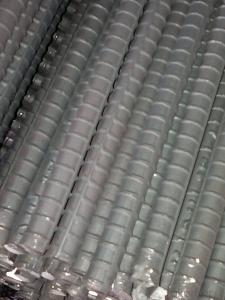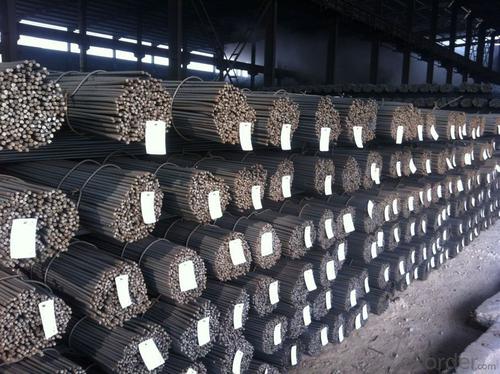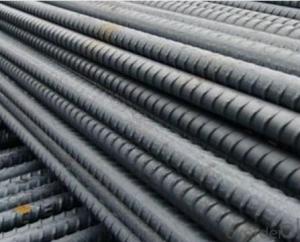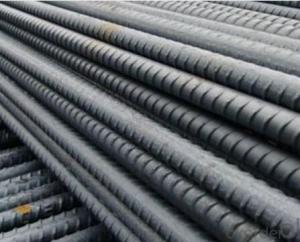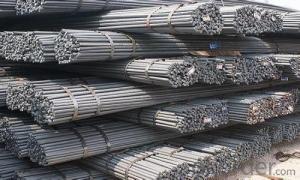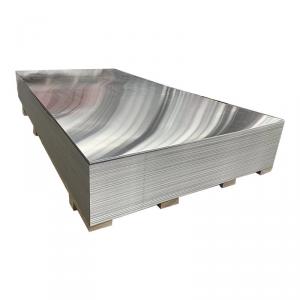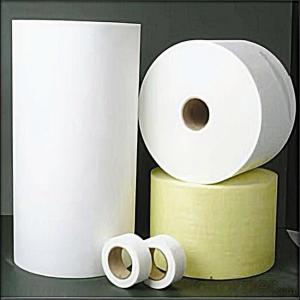Reinforcing Bars for Construction Concrete Steel Rebars
- Loading Port:
- China main port
- Payment Terms:
- TT OR LC
- Min Order Qty:
- 100 m.t.
- Supply Capability:
- 10000 m.t./month
OKorder Service Pledge
OKorder Financial Service
You Might Also Like
Product Description:
OKorder is offering Steel Reinforcing Rebars for Construction Concrete at great prices with worldwide shipping. Our supplier is a world-class manufacturer of steel, with our products utilized the world over. OKorder annually supplies products to African, South American and Asian markets. We provide quotations within 24 hours of receiving an inquiry and guarantee competitive prices.
Product Applications:
Steel Reinforcing Rebars for Construction Concrete are ideal for structural applications and are widely used in the construction of buildings and bridges, and the manufacturing, petrochemical, and transportation industries.
Product Advantages:
OKorder's Steel Reinforcing Rebars for Construction Concrete are durable, strong, and wide variety of sizes.
Main Product Features:
· Premium quality
· Prompt delivery & seaworthy packing (30 days after receiving deposit)
· Can be recycled and reused
· Mill test certification
· Professional Service
· Competitive pricing
Product Specifications:
Manufacture: Hot rolled
Grade: HRB335,HRB400,HRB500
Certificates: ISO, SGS, BV, CIQ
Length: 6m – 12m, as per customer request
Packaging: Export packing, nude packing, bundled
Deformed Steel Bar | ||
Diameter (MM) | Cross Sectional Area (MM2) | Theorectical Weight (KG/M) |
6 | 28.27 | 0.222 |
8 | 50.27 | 0.395 |
10 | 78.54 | 0.617 |
12 | 113.1 | 0.888 |
14 | 153.9 | 1.21 |
16 | 201.1 | 1.58 |
18 | 254.5 | 2 |
20 | 314.2 | 2.47 |
22 | 380.1 | 2.98 |
25 | 490.9 | 3.85 |
28 | 615.8 | 4.83 |
32 | 804.2 | 6.31 |
36 | 1018 | 7.99 |
40 | 1257 | 9.87 |
Grade | Technical data of the original chemical composition (%) | |||||||
C | Mn | Si | S | P | B | |||
HRB335 | ≤0.25 | ≤1.60 | ≤0.80 | ≤0.045 | ≤0.045 | >0.0008 | ||
Physics capability | ||||||||
Yield Strength(N/cm2) | Tensile Strength(N/cm2) | Elongation (%) | ||||||
≥335 | ≥490 | ≥16 | ||||||
FAQ:
Q1: what is the difference between actual weight and theoretical weight?
A1: All the section steel has two weights: actual weight and theoretical weight. Actual weight is the weighing out when the product delivered from the mill. Theoretical weight is calculated by pieces. The invoice can be based on each of them as your request.
Q2: How many tons of steel products could be loaded in containers?
A2: Usually the steel products are delivered by bulk vessel because of the large quantity and the freight. However, there are no bulk vessel enter some seaports so that we have to deliver the cargo by containers. The 6m steel product can be loaded in 20FT container, but the quantity is changed according to the size, usually from 18tons to 25tons.
Q3: How soon can we receive the product after purchase?
A3: Within three days of placing an order, we will arrange production. The normal sizes with the normal grade can be produced within one month. The specific shipping date is dependent upon international and government factors, the delivery to international main port about 45-60days.
Images:

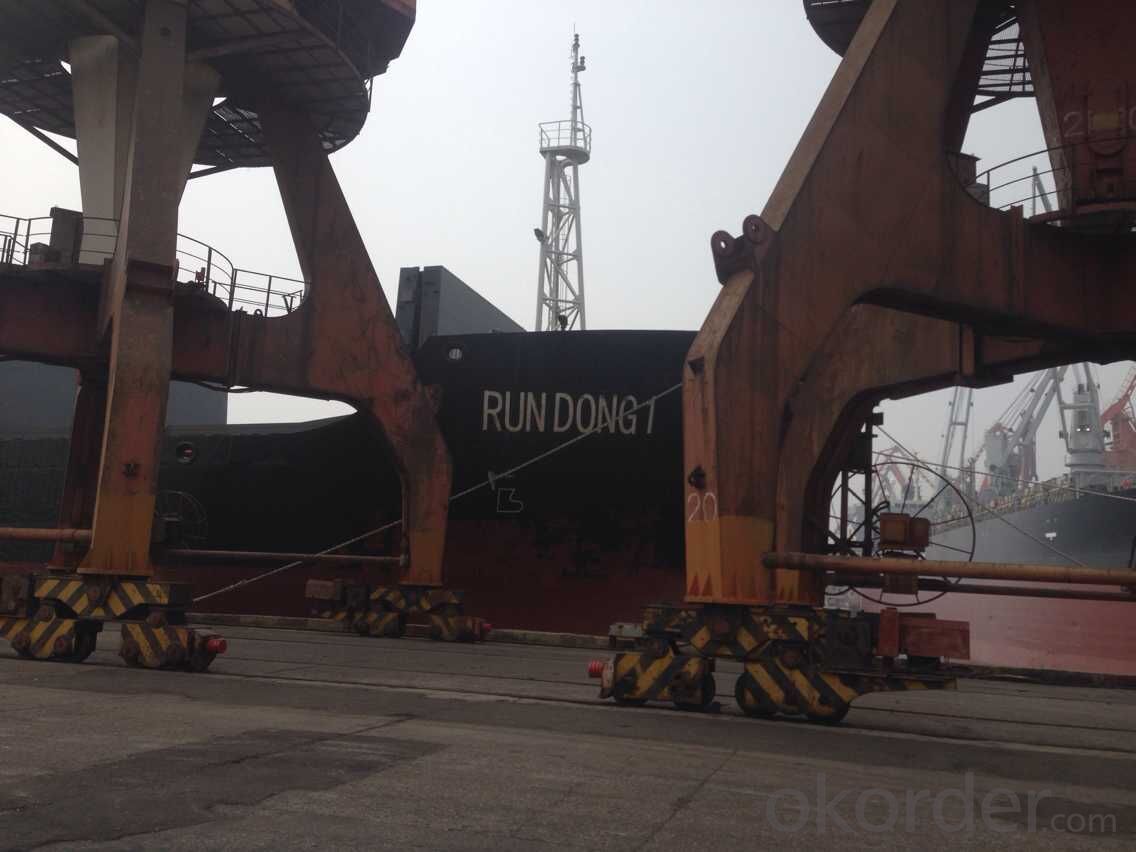
- Q:How are steel rebars used in the construction of dams?
- The construction of dams relies heavily on steel rebars, as they offer the necessary strength and stability to the structure. Dams, which are massive concrete constructions designed to contain water for various purposes like hydroelectric power generation, irrigation, and flood control, greatly benefit from the presence of steel rebars. Steel rebars, also referred to as reinforcing bars, are essential in reinforcing the concrete and enhancing its ability to withstand tension. Although concrete is excellent at withstanding compression, it is relatively weak when it comes to tension. This is where steel rebars come into play, as they are strategically positioned inside the concrete structure to counteract any tensile forces that may lead to cracks or failure. Typically, in the construction of dams, steel rebars are embedded within the concrete in a crisscross manner, forming a network of reinforcement. This configuration helps to evenly distribute the load and resist the immense pressure exerted by the water behind the dam. By reinforcing the concrete, steel rebars ensure that the dam can withstand various forces, including the weight of the water, water pressure, and external factors such as earthquakes. Moreover, steel rebars also serve to prevent cracks from spreading within the concrete. In the event of minor cracks caused by environmental factors or settlement, the rebars act as a barrier, preventing the cracks from expanding and compromising the structural integrity of the dam. To ensure their strength and durability, steel rebars used in dam construction must meet specific standards and specifications. Typically, they are made from high-strength steel capable of withstanding the immense pressures and forces encountered during dam construction. In conclusion, the presence of steel rebars is vital in the construction of dams as they reinforce the concrete, provide the necessary strength and stability, and prevent the propagation of cracks. Their strategic placement and configuration aid in load distribution, tension resistance, and the maintenance of the dam's structural integrity and reliability.
- Q:How do steel rebars contribute to the strength of concrete?
- Steel rebars contribute to the strength of concrete in several ways. Firstly, they enhance the tensile strength of concrete, which is otherwise relatively low. While concrete is excellent in compression, it is weak when it comes to resisting tension. This is where steel rebars come into play. By embedding them within the concrete, they provide additional strength and help prevent the formation and propagation of cracks. Secondly, steel rebars improve the bond between concrete and the reinforcement material. The ribbed surface of the rebars creates a better grip with the concrete, ensuring a stronger bond. This bond is crucial as it allows the concrete and steel to work together, distributing the loads and minimizing the risk of structural failure. Furthermore, steel rebars increase the overall durability and longevity of concrete structures. They resist corrosion, which is a significant concern in coastal or high humidity areas. The corrosion resistance of rebars ensures that the concrete remains structurally sound for a longer period, reducing maintenance costs and extending the lifespan of the structure. In addition to their strength-enhancing capabilities, steel rebars also contribute to the structural stability of concrete elements. They assist in reinforcing critical areas such as beams, columns, and foundations, where high loads and forces are present. By providing additional support and reinforcement, steel rebars help prevent excessive deflection, bending, or failure of these elements under heavy loads. In summary, steel rebars play a vital role in enhancing the strength of concrete structures by improving tensile strength, bond strength, durability, and overall structural stability. Their incorporation in concrete elements is essential for ensuring the longevity and safety of various construction projects.
- Q:How is steel rebar manufactured?
- Steel rebar, or reinforcing bar, is manufactured through a process known as steelmaking. The manufacturing process involves several steps to ensure the production of high-quality and durable rebar. The first step in manufacturing steel rebar is the selection and preparation of raw materials. Iron ore, coal, and limestone are the primary raw materials used in steelmaking. Iron ore is extracted from mines and then processed to remove impurities. Coal is used as a fuel source to heat the iron ore, while limestone acts as a flux to remove impurities during the heating process. Once the raw materials are prepared, they are combined in a blast furnace. The blast furnace is a large, cylindrical structure where the iron ore, coal, and limestone are heated to extreme temperatures. The intense heat causes a chemical reaction that separates the iron from the impurities, resulting in molten iron. The molten iron is then transferred to a basic oxygen furnace (BOF) or an electric arc furnace (EAF). In the BOF process, the molten iron is combined with scrap steel and other alloys to create the desired steel composition. Oxygen is blown into the furnace, which removes impurities and adjusts the carbon content. In the EAF process, electricity is used to melt the scrap steel and other alloys, and chemical reactions occur to adjust the composition and remove impurities. After the steel has been produced, it is poured into continuous casting machines, which shape the steel into long, rectangular strands called billets. These billets are then passed through a series of rolling mills, which gradually reduce their size and shape them into the desired cross-sectional profile. The rolling process also enhances the strength and durability of the steel. Once the rebar has been rolled, it undergoes a process called quenching and tempering. This involves rapidly cooling the rebar in water to increase its hardness, followed by reheating it to a specific temperature and then cooling it slowly. This process helps improve the rebar's strength and ductility, making it suitable for reinforcement in concrete structures. Finally, the rebar is cut into desired lengths and often undergoes surface treatment, such as galvanization or epoxy coating, to enhance its corrosion resistance. It is then bundled and shipped to construction sites, where it is used to reinforce concrete structures like buildings, bridges, and roads. In summary, the manufacturing of steel rebar involves the selection and preparation of raw materials, the melting and refining of iron in a blast furnace or electric arc furnace, the shaping of the steel into billets through continuous casting and rolling, the quenching and tempering process to improve its strength and ductility, and the final cutting and surface treatment before it is ready for use in construction projects.
- Q:Are there any disadvantages of using steel rebars in construction?
- Yes, there are some disadvantages of using steel rebars in construction. One major drawback is that steel is prone to corrosion, especially in humid or coastal areas, leading to structural deterioration over time. Additionally, steel rebars are heavy and require specialized equipment for transportation and installation, which can increase construction costs. Lastly, steel production has a significant environmental impact due to the extraction and processing of raw materials, contributing to carbon emissions and depletion of natural resources.
- Q:What is the process of connecting steel rebars to structural members?
- The process of connecting steel rebars to structural members involves several steps to ensure a secure and reliable connection. Firstly, the rebars, which are typically long, steel bars with ridges or deformations on their surface, need to be accurately positioned within the structural member according to the design specifications. This is often done by using spacers or chairs to maintain the proper spacing between the rebars and the surrounding formwork. Next, the rebars are joined to the structural member using various methods. One common method is through lap splicing, where the rebars are overlapped for a certain distance and then tied together using wire or mechanical connectors. The length of the overlap is determined by engineering calculations to ensure sufficient strength and load transfer. Another method is the use of mechanical couplers, which are pre-fabricated devices that provide a reliable connection between rebars. These couplers are designed to grip the rebars tightly and transfer the load effectively. They offer advantages such as faster installation, reduced labor costs, and improved structural integrity. In addition to splicing, the rebars may also need to be anchored or hooked into the structural member. Anchoring involves extending the length of the rebar beyond the connection point and then bending it back into the concrete, creating a hook shape. This provides additional resistance to the pull-out forces. Throughout the process, it is crucial to ensure that the rebars are clean, free from rust, and properly aligned. Any contaminants or misalignments can weaken the connection and compromise the structural integrity. Therefore, thorough inspection and quality control measures are essential to ensure a successful connection. Overall, the process of connecting steel rebars to structural members involves careful planning, accurate positioning, proper splicing or coupling, and thorough inspection. By following these steps, a strong and durable connection can be achieved, ensuring the safety and stability of the structure.
- Q:Can steel rebars be used in modular bridge construction?
- Yes, steel rebars can be used in modular bridge construction. Steel rebars provide strength, durability, and structural stability to the bridge modules, making them an ideal choice for this type of construction.
- Q:How are steel rebars inspected for quality control?
- Steel rebars are inspected for quality control through various methods such as visual inspection, dimensional checks, and mechanical testing. Visual inspection involves checking for any visible defects, such as rust, cracks, or surface irregularities. Dimensional checks ensure that the rebars meet the required specifications in terms of length, diameter, and shape. Mechanical testing involves conducting tests like tensile strength, yield strength, and bend tests to verify the rebars' performance and structural integrity. Additionally, rebars may undergo non-destructive testing techniques like ultrasonic testing or magnetic particle inspection to detect any internal flaws or defects. These inspection processes help ensure that steel rebars meet the necessary quality standards and are suitable for their intended applications in construction projects.
- Q:Can steel rebars be used in highway barrier construction?
- Yes, steel rebars can be used in highway barrier construction. They are commonly used as reinforcement in concrete barriers to enhance their strength and durability.
- Q:Can steel rebars be used in the construction of dams or reservoirs?
- Yes, steel rebars can be used in the construction of dams or reservoirs. Steel rebars provide structural reinforcement and enhance the strength and durability of concrete structures, making them suitable for large-scale projects like dams and reservoirs.
- Q:What is the average weight of steel rebars per meter?
- The average weight of steel rebars per meter can vary depending on the diameter and type of rebar used. However, on average, a standard 1-meter length of steel rebar weighs around 2.5 to 3 kilograms.
1. Manufacturer Overview |
|
|---|---|
| Location | |
| Year Established | |
| Annual Output Value | |
| Main Markets | |
| Company Certifications | |
2. Manufacturer Certificates |
|
|---|---|
| a) Certification Name | |
| Range | |
| Reference | |
| Validity Period | |
3. Manufacturer Capability |
|
|---|---|
| a)Trade Capacity | |
| Nearest Port | |
| Export Percentage | |
| No.of Employees in Trade Department | |
| Language Spoken: | |
| b)Factory Information | |
| Factory Size: | |
| No. of Production Lines | |
| Contract Manufacturing | |
| Product Price Range | |
Send your message to us
Reinforcing Bars for Construction Concrete Steel Rebars
- Loading Port:
- China main port
- Payment Terms:
- TT OR LC
- Min Order Qty:
- 100 m.t.
- Supply Capability:
- 10000 m.t./month
OKorder Service Pledge
OKorder Financial Service
Similar products
New products
Hot products
Hot Searches
Related keywords
